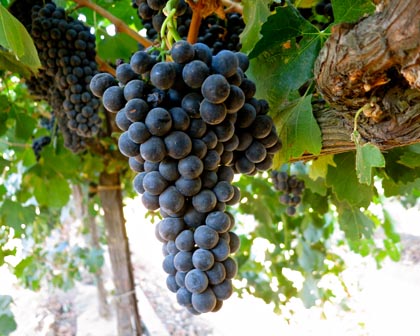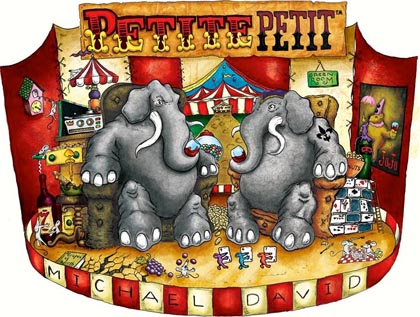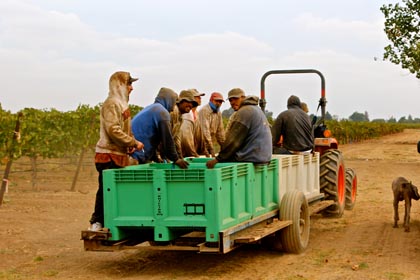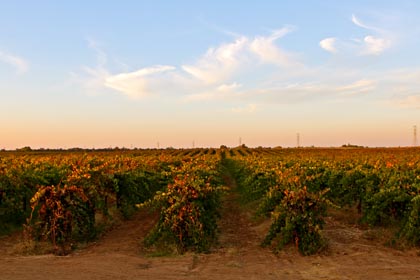Letters from Lodi
An insightful and objective look at viticulture and winemaking from the Lodi
Appellation and the growers and vintners behind these crafts. Told from the
perspective of multi-award winning wine journalist, Randy Caparoso.
Lodi positioned to ride the growing passion for Petite Sirah
Phillips Farms Petite Sirah (grown for Michael David Winery)
While American wine lovers are familiar with Syrah – often sold as Shiraz on Australian labels – the popularity of this grape as a varietal red wine has been on a notable wane in recent years.
Petite Sirah, on the other hand, has become more popular than ever. It is not the same grape as Syrah: it is a crossing of two grapes, Syrah and Peloursin, originally developed in Southern France in the 1880s, and introduced to California shortly thereafter (about 1884). Although wine connoisseurs have always considered Syrah to be the far greater of the two grapes, many American consumers now prefer Petite Sirah over Syrah.
When it comes to wine, as the old Latin phrase goes, de gustibus non est disputandum ("there is no disputing in matters of taste"): these particular wine lovers know what they like, and their passion is Petite!
In the Lodi AVA – a region typified by a Mediterranean climate that is strikingly similar to original European home of all the classic wine grapes – few wineries have parlayed the recent popularity of this variety as successfully as Michael David Winery.
Fun depiction of two “monster” grapes
The largest of Lodi's premium producers (now topping 400,000 cases in yearly production), Michael David has been bottling two separate versions of Petite Sirah, both highlighting the most appealing aspects of the grape, and both selling like hotcakes. The two current releases:
- The inky black-purplish, no-holds-barred 2010 Michael David, Earthquake Lodi Petite Sirah ($26); replete with unabashedly oak driven, blackberry and blueberryish aromas tinged with notes of smoked bacon; big, chunky, even funky in the mouth, yet ultimately compelling, like a big-buckled Elvis painted on black velvet canvas.
- A kinder, gentler 2011 Michael David, Lodi Petite Petit ($18) – blended with about 15% Petit Verdot (the latter, one of the five major black skinned grapes originating from France's Bordeaux region) – yet still a vivid black-ruby in color, showing off flamboyantly ripe, plummy aromas infused with notes of peppery beef bouillon and smoked bacon; the exuberant, plummy flavors continuing in a dense, medium-full body, filled out by smooth yet generous tannin.
"People have been loving these wines," says Michael David President/Co-Owner David Phillips. "The Petite Petit has the more colorful 'circus' label, and brings out the fun side of the grape. When Petite Sirah is blended with Petit Verdot, the two grapes seem to counter-balance each other. Each variety produces monster flavors, but together they seem to make each other more approachable. I don't understand the chemistry behind it, but it works.
David Phillips (at his yearly Reggae & Rhone party)
"While Petite Petit has been the crowd pleaser," adds Phillips, "the Earthquake Petite Sirah is still the showiest wine we make. It's just a black monster of a wine – good for cold, snowy evenings by the fireplace." Throw in a good roast or some open fire grills, and the crowd cheers for more!
There is, of course, a number of other first class Petite Sirahs grown in Lodi. At the tip of our tongue: McCay Cellars produces a supple, elegant expression of the grape; Viñedos Aurora‘s is chunky and chock-full of peppery spice; Ironstone crafts a soft yet beautifully scented, earthen-nuanced bottling; Mettler Family‘s is masculine, muscular and spicy; and at usually around $12, Oak Ridge‘s Maggio brand Petite Sirah is a smooth and easy “best buy.”
How popular has Petite Sirah become among consumers? Enough to get growers scrambling to plant more. Plantings of the grape in California now exceed 8,335 acres, according to 2012 USDA reports. This is far cry from grapes like Cabernet Sauvignon (over 80,00 acres), Zinfandel (+47,000 acres) and Pinot Noir (+39,000 acres); but still a significant increase from a previous low of 2,400 acres of Petite Sirah planted in 1995.
Out of the state's total, Lodi cultivates the most — about 2,000 acres of Petite Sirah (San Luis Obispo weighs in with the second most acreage, about 1,400) — and new plantings are going in to meet the demand as we speak.
Phillips Farms Petite Sirah pickiing crew
California's Petite Sirah plantings actually peaked at 14,000 acres in 1976; but those were the days when the grape was blended into jug wines like Gallo's Hearty Burgundy (usually with Zinfandel and Carignan). Only a few dozen producers were bottling varietal Petite Sirah during the '60s and '70s. Then again, those were the days when red Zinfandel bottlings were also falling in popularity; and virtually no one produced Carignan as a varietal wine, despite the fact that it was the most widely planted red wine grape in California at that time.
This time around things are different: like Zinfandel, Petite Sirah has carved out its own varietal niche. When PS I Love You, the Petite Sirah advocacy group, was founded in 2002, the number of wineries producing varietal Petite Sirah had inched up to 67. Then came the explosion: today there are over 850 brands of Petite. PS I Love You's founding director, Jo Diaz, explains the grape's dramatic growth in this way: "trade people love to sell this variety as a sleeper, and tasting rooms outsell each vintage before its time." Orson Welles, we hardly knew ye.
Petite Sirah, in a word, has established its own identity, even mystique. This is ironic, considering that not too long ago the variety was commonly confused with Syrah. In fact, it is still often misspelled as "Petite Syrah." Petite Sirah, for the record, is actually the Americanized name for the true (technically) name of the grape, which is Durif – for François Durif, the 19th century Southern French botanist who developed this Syrah-Peloursin crossing.
Ultimately, the important thing to know is that, on a sensory level, Petite Sirah produces a rich, satisfying, full bodied red wine that is dependably appealing; whether bottled as a full throttled red wine selling for $25 to $50 (or more), or as a rounder, gentler red retailing for $10 to $18. It's a whole new equation: PS = easy-to-love!
Autumn sunset over Vindos Aurora’s Petite Sirah vines




